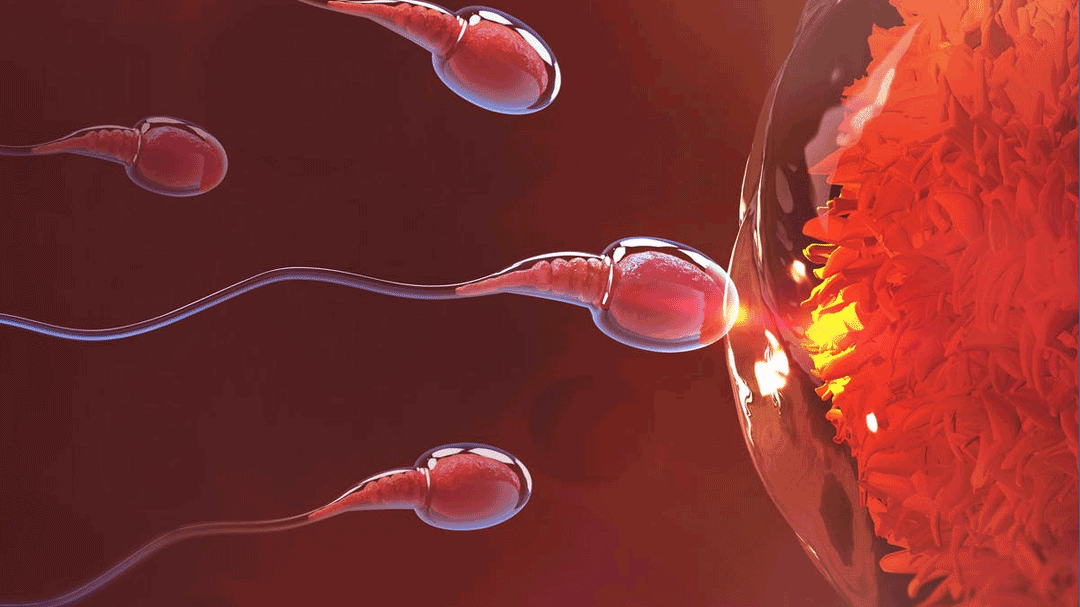
Video Lecture
Variation
Without variation, there can be no selection and, consequently, no evolution. Variation arises from mutations, genetic recombination, genetic drift, gene flow (population migration), and of course, from reshuffling the genes through sexual reproduction. Species show remarkable stability in their gene pools since even minor variations in the genotype can produce significant phenotypic changes. Chimpanzees, Pan troglodytes, and humans, Homo sapiens sapiens, have only about 5% different DNA (Wetterbom et al., 2006). The frequencies of alleles (variations in a gene) remain constant without selection, mutation, migration, and genetic drift (Ewens, 2004).
A mutation is a change in the genes of an organism. It can occur thru copying errors in the genetic material during cell division (reproduction), by exposure to radiation, chemical mutagens, or viruses (Gershenson, 1986). The organism can also induce these errors by hypermutation (a reaction within the cells to resist foreign elements) (Janeway et al., 2005). Humans pass 60 new mutations to their children on average, with fathers passing more mutations depending on their age, with every year adding two new mutations to a child (Kong et al., 2012).
Most mutations do not affect the fitness of an organism and can accumulate due to genetic drift.
The idea that mutations occur randomly as to their consequences has prevailed in evolutionary biology until recently (Futuyma, 1986). However, studies in 2022 in the plant Arabidopsis thaliana show that mutations occur less often in functionally constrained regions of the genome—mutation frequency decreases by half inside gene bodies and by two-thirds in essential genes (e.g., genes involved in cell growth and expression). By contrast, genes with environmentally conditional functions have the highest mutation rates. The plant seems to have evolved to protect its most important gene places from mutation. DNA damage repair also seems to be particularly effective in these regions (Monroe et al., 2022).
Genetic recombination is the process by which a strand of DNA (sometimes RNA) breaks and joins a different DNA molecule. Recombination occurs during meiosis (halving the number of chromosomes during reproduction) between paired chromosomes. This process causes the offspring to show different combinations of genes from their parents.
Genetic drift (more correctly, allelic drift) is the change in the relative frequency with which an allele (gene variant) occurs in a population. A gene’s relative frequency changes because its alleles in the offspring are a random sample of the genes in their parents and because there is a random element in whether a particular individual survives and reproduces. Sometimes gene variants become extinct because of genetic drift, which reduces the genetic variation in the population’s gene pool.
Genetic drift is not due to environmental pressure (adaptation) and may be beneficial, neutral, or detrimental to reproductive success. The effect of genetic drift is mostly irrelevant in larger populations, though crucial in smaller populations (Purves et al., 2003).
Gene flow (or population migration) is the transfer of alleles from one population to another that occurs when migration into or out of a population causes a change in a particular allele’s frequency. Immigration adds new genetic variants to the established gene pool of a population. A regular gene flow between two populations reduces the genetic variation between the two and counteracts speciation. While genetic drift tends to create speciation (especially in small populations), gene flow does the opposite.
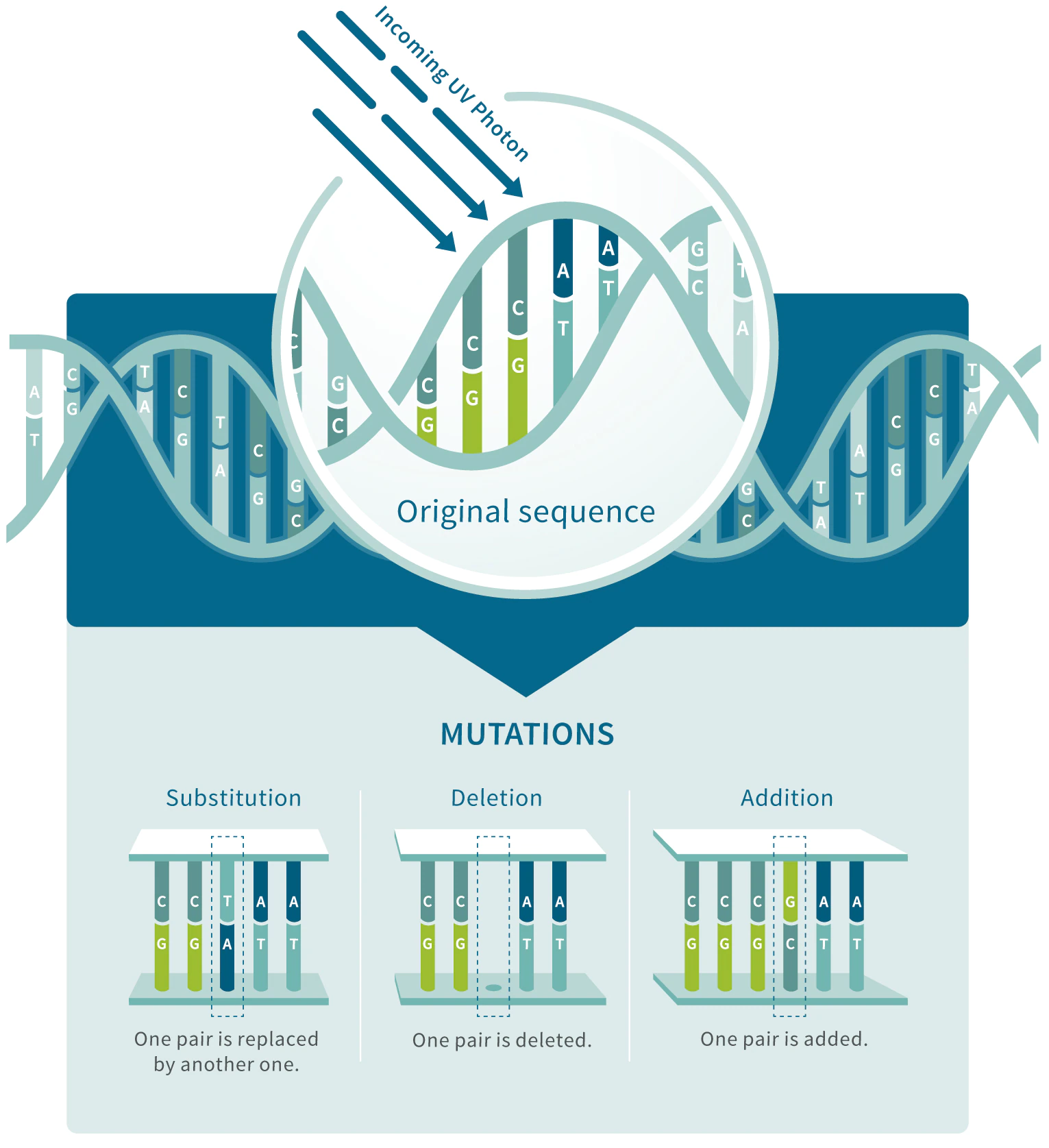
Illustration shows how UV light from the sun could cause some mutations.
Substitution: A substitution exchanges one base for another. For example, the DNA sequence CAGTAG becomes CAATAG.
Deletion: A deletion takes out individual bases or an entire segment of DNA. For example, the DNA sequence CAGTAG becomes CATAG.
Addition (or insertion): An addiction adds extra bases to a DNA sequence. For example, the DNA sequence CAGTAG becomes CATGTAG.
In addition, mutations may also happen by inversion and repeat expansion.
Inversion: An inversion happens when a sequence of DNA is reversed. For example, the DNA sequence CAGTAG becomes GATGAC.
Repeat expansion: A repeat expansion copies the same DNA sequence one or more times. For example, the DNA sequence CGGCGGCGG becomes CGGCGGCGGCGGCGGCGG .
Illustration from AncestryDNA Learning Hub
Charles Darwin
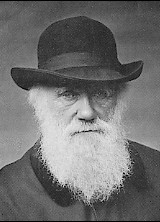 Charles Robert Darwin (12 February 1809 – 19 April 1882) was an English naturalist. His theory of evolution by natural selection, maybe the most brilliant human idea ever, is essential to the modern understanding of evolution with immense repercussions, not only in biology but also in most other sciences.
Charles Robert Darwin (12 February 1809 – 19 April 1882) was an English naturalist. His theory of evolution by natural selection, maybe the most brilliant human idea ever, is essential to the modern understanding of evolution with immense repercussions, not only in biology but also in most other sciences.
He published, in 1859, “On The Origin of Species by Means of Natural Selection, or The Preservation of Favoured Races in the Struggle for Life,” commonly known as “The Origin of Species.” Later works include “The Descent of Man and Selection in Relation to Sex,” followed by “The Expression of the Emotions in Man and Animals.” He also wrote a series of books containing his research on plants, and in his final book, he studied earthworms and their effect on soil.
Picture: Charles Darwin in 1880.
Alfred Russel Wallace
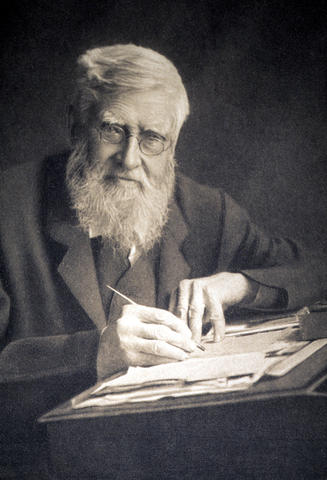 Alfred Russel Wallace (8 January 1823 – 7 November 1913) was a British naturalist, geographer, anthropologist, and biologist. He developed the theory of natural selection by means of natural selection in the same period as Darwin and contributed to the development of Darwinism.
Alfred Russel Wallace (8 January 1823 – 7 November 1913) was a British naturalist, geographer, anthropologist, and biologist. He developed the theory of natural selection by means of natural selection in the same period as Darwin and contributed to the development of Darwinism.
In 1867, he was the first to refer to what we now call mimicry. In 1889, in “Darwinism,” he presented the Wallace effect, suggesting that natural selection could contribute to the development of new species by being a factor in the reproductive isolation of varieties and by encouraging the development of constraints for hybridization.
Picture: Wallace in 1913 from Marchant.
Sexual Reproduction
Sexual reproduction is the process by which a particular combination of genes (genetic information) passes from parent to offspring. The main two mechanisms of sexual reproduction are (1) meiosis (halving of the number of chromosomes) and (2) fertilization (the fusion of two gametes, one from each parent, restoring the original number of chromosomes).
The first sexually reproducing organisms were eukaryotes from 1 to 1.2 billion years ago. Eukaryotes are organisms whose cells are organized into complex structures and enclosed within membranes. Animals, plants, fungi, and protists are eukaryotes. Most macroscopic organisms, including almost all animals and plants, reproduce sexually.
Sexual reproduction is more widespread than parthenogenesis (asexual reproduction where the female produces eggs that develop without fertilization), probably because a sexually reproducing population can respond quicker to environmental changes than parthenogenesis allows and also decreases the chance of deleterious mutations accumulating irreversibly.
Mutations, recombinations, gene drift, gene flow, and sexual reproduction create variation, and some organisms will be better adapted (fit in better) than others to the prevailing environment.
The evolution of sexual reproduction is somehow paradoxical, given that if an organism is capable of producing its offspring, asexual reproduction should outperform sexual reproduction in terms of efficiency (Otto & Lenormand, 2002). That suggests that an asexual population has the inherent ability to increase in size with each succeeding generation. Sexual reproduction has a fitness disadvantage because of this 50% cost. The main costs of sex are this expense and the fact that any organism can only pass on 50% of its genes to its offspring.
The paradox is such that it prompted W. D. Hamilton to write: “Clearly, if you are a gene with some say in what the genome does, then to allow your bearer to waste half her descendant biomass in each generation on a seemingly pointless production of maleness certainly isn’t itself a good idea; in fact you lose out and disappear extremely fast compared with a gene preventing maleness. But if being around with males, however idle they may be, or having your daughters be around with then, mysteriously brings into your stock some splendid and at least twofold vigour […] the case might be very different” (Hamilton, 1996).
Despite its disadvantages, sexual reproduction also shows advantages, or else it would not have evolved. Advantages are: (1) a decrease in the accumulation of deleterious mutations, (2) an increase in the rate of adaptation to changing environments, (3) coping with competition, (4) DNA repair, and (5) a decrease in genetic variation at the genomic level (Gorelick & Heng, 2011). Ultimately, whether sexual reproduction is advantageous depends on the size of the population. Larger populations appear to respond more swiftly to some of the benefits received through sexual reproduction than do smaller populations (Colegrave, 2002).
One possible explanation for the fact that nearly all vertebrates are sexual is that sex increases the rate at which adaptation can occur. That is for two reasons. First, suppose an advantageous mutation occurs in an asexual line. In that case, that mutation can’t spread without wiping out all other lines, which may have different beneficial mutations of their own. Secondly, it mixes up alleles. Some genetic variation instances might be advantageous only when paired with other mutations, and sex increases the likelihood that such pairings will occur.
For sex to be advantageous for these reasons, it requires a continuous selection for changing conditions. One factor that might cause this is the constant arms’ race between parasites and their hosts (the “Red Queen Paradox,” a term coined by Matt Ridley in 1993). Parasites generally evolve quickly due to their short lifespans. As they evolve, they attack their hosts in a variety of ways. Two consecutive generations might face very different selective pressures. If this change is rapid enough, it might explain the persistence of sex.
Sexual reproduction introduces a certain variation in a population, though not at the genomic and epigenetic level (Gorelick &Heng, 2011), without which natural selection would not be possible. It also introduces sexual selection into the equation, the choice of a mate, a selective factor as powerful as natural selection (Dimijian, 2005).
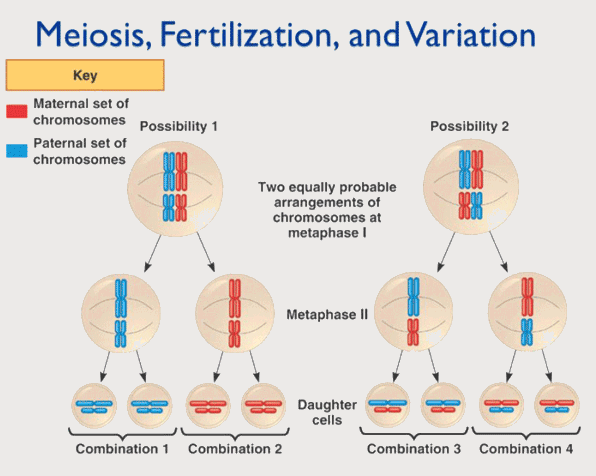
Sexual reproduction includes meiosis and fertilization.The chromosomes assort independently during metaphase I of meiosis so that the possible arrangements of chromosomes contained within any given gamete is totally random, never predetermined (Illustration by Eunice McDowell).
Movie from Simple Medicine
We Share 40% Protein Coding Genes with Bananas
All animals and plants share the same type of DNA. DNA consists of codes for the amino acids which produce proteins. These codes are like combinations of four letters.
Parent and child share 99.5% of the same protein-coding genes; all humans share 99%. We share 98% DNA with chimpanzees, 61% with fruit flies, and about 40% with bananas. About 60 percent of our genes have a recognizable counterpart in the banana genome. Of those 60 percent, the proteins encoded by them are roughly 40 percent identical when we compare the amino acid sequence of the human protein to its equivalent in the banana. Note that genes—the DNA regions that code for proteins—only make up about 2% of our DNA. 8% have regulatory functions, and 90% (called junk-DNA) are either non-functional or have functions we do not know yet.
Bananas and humans need similar environments. For survival, body repair, and growth, both need oxygen, some common nutrients, minerals, and water; both reproduce sexually and grow from embryos. Thus, the biochemical processes within a human and a banana cell have common aspects. Similar biochemical functions require similar sets of genes to code for the enzymes. We may look very different from bananas, yet we require many related genes at a cellular level.
We are different from chimpanzees and bananas, not so much because of the percentage of DNA we do not share, but because of how genes are controlled and how and for how long they are switched on and off.
All life on Earth has evolved from an organism, LUCA (Last Universal Common Ancestor), that originated and probably lived in the high-temperature water of deep-sea vents near ocean-floor magma flows about four billion years ago (Betts et al., 2018). Indeed, we are all relatives, as Darwin supposed: “Therefore I should infer from analogy that probably all the organic beings which have ever lived on this earth have descended from some one primordial form, into which life was first breathed.” (Darwin, 1859).
References
Betts, H. C.; Puttick, M. N.; Clark, J. W.; Williams, T. A.; Donoghue, P. C. J.; Pisani, D. (2018). Integrated genomic and fossil evidence illuminates life’s early evolution and eukaryote origin (PDF). Nature Ecology & Evolution. 2 (10): 1556–1562. doi:10.1038/s41559-018-0644-x. PMC 6152910. PMID 30127539.
Colegrave, N (2002). Sex releases the speed limit on evolution. Nature. 420 (6916): 664–6. Bibcode:2002Natur.420..664C. doi:10.1038/nature01191. hdl:1842/692. PMID 12478292. S2CID 4382757.
Darwin, C. (1859) On the origin of species by means of natural selection, or the preservation of favoured races in the struggle for life. London: John Murray. 1st ed.
Dimijian, G. G. (2005). Evolution of sexuality: biology and behavior. Proc (Bayl Univ Med Cent). 2005 Jul; 18(3): 244–258. doi: 10.1080/08998280.2005.11928075. PMID: 16200180; PMCID: PMC1200732.
Ewens, W. J. (2004). Mathematical Population Genetics. Interdisciplinary Applied Mathematics. Vol. I. Theoretical Introduction (2nd ed.). New York: Springer-Verlag N.Y. ISBN 978-0-387-20191-7.
Futuyma, D. J. (1986). Evolutionary Biology. (2nd ed.). Sinauer Associates Inc. Sunderland, Mass. https://doi.org/10.1046/j.1420-9101.1988.1010089.x
Gershenson S.M. (1986). Viruses as environmental mutagenic factors. Mutat Res. 1986 May;167(3):203-13. doi: 10.1016/0165-1110(86)90030-8. PMID: 3083244.
Gorelick, R. and Heng, H.H.Q. (2011). Sex Reduces Genetic Variation: A Multidisciplinary Review. Evolution, 65: 1088-1098. https://doi.org/10.1111/j.1558-5646.2010.01173.x
Hamilton, W.D. (1996). Narrow Roads of Gene Land: Volume 2: Evolution of Sex. Oxford Univ. Press. ISBN-10: 0198503369. ISBN-13: 978-0198503361.
Janeway, C.A.; Travers, P.; Walport, M.; Shlomchik, M.J. (2005). Immunobiology (6th ed.). Garland Science. ISBN 978-0-8153-4101-7.
Kong, A., Frigge, M., Masson, G. et al. (2012). Rate of de novo mutations and the importance of father’s age to disease risk. Nature 488, 471–475 (2012). https://doi.org/10.1038/nature11396.
Maynard Smith, J. (1971). The origin and maintenance of sex. In G. C. Williams, ed. Group Selection. Aldine Atherton, Chicago. eBook ISBN: 9780203790427.
Maynard Smith, J. (1978). The Evolution of Sex. Cambridge University Press, Cambridge, UK. ISBN 10: 052121887X ISBN 13: 9780521218870.
Monroe, J.G., Srikant, T., Carbonell-Bejerano, P. et al. (2022). Mutation bias reflects natural selection in Arabidopsis thaliana. Nature 602, 101–105 (2022). https://doi.org/10.1038/s41586-021-04269-6.
Otto, Sarah P.; Lenormand, Thomas (2002). Resolving the paradox of sex and recombination. Nature Reviews Genetics. 3 (4): 252–261. doi:10.1038/nrg761. PMID 11967550. S2CID 13502795.
Purves, W. K., Sadava, D., Orians, G. H., and Heller, H. C. (2003). Genetic drift may cause large changes in small populations. In Life: The Science of Biology (7th ed., pp. 468-469). Sinauer Associates and W. H. Freeman. ISBN-13: 978-0716798569. ISBN-10: 0716798565.
Ridley, M. (1993). The Red Queen: Sex and the Evolution of Human Nature. Viking Books. ISBN: 978-0060556570.
Theobald, D. (2010). A formal test of the theory of universal common ancestry. Nature. 465. 219-22. 10.1038/nature09014.
Wetterbom, Anna; Sevov, Marie; Cavelier, Lucia; Bergström, Tomas F. (November 2006). Comparative Genomic Analysis of Human and Chimpanzee Indicates a Key Role for Indels in Primate Evolution. Journal of Molecular Evolution. 63 (5): 682–690. Bibcode:2006JMolE..63..682W. doi:10.1007/s00239-006-0045-7. ISSN 0022-2844.
